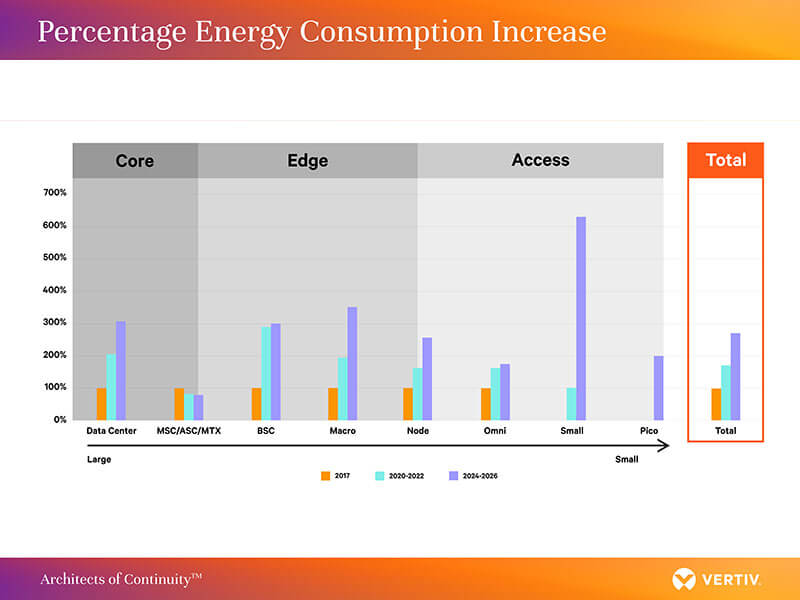Operators are optimistic about the future services 5G will enable, but estimates suggest network energy consumption could increase by up to 170 percent by 2026
Singapore [Feb. 28, 2019] – Vertiv, together with technology analyst firm 451 Research, has released the findings of an in-depth survey which reveals a good sense of optimism about the services 5G will enable and the interplay with edge computing. The majority of telecoms operators surveyed believe the 5G era will start in earnest in 2021 in all geographies, with 88 percent of respondents planning to deploy 5G in 2021-2022.
However, more than 90 percent of respondents believe 5G will result in higher energy costs and are interested in technologies and services that improve efficiency. This is consistent with internal analysis by Vertiv, which finds the move to 5G is likely to increase total network energy consumption by 150-170 percent by 2026, with the largest increases in macro, node, and network data center areas.
The survey questioned more than 100 global telecoms operators about the opportunities and potential obstacles of deploying 5G services and the impact on edge computing adoption. Vertiv and 451 Research shared details of the findings at Mobile World Congress on February 27th in Barcelona, Spain.
“There’s no doubt that 5G is the next big thing for communications and mobile networks. It is understandable, however, that there are concerns when it comes to deploying this technology. It is critical for operators to have the right infrastructure in place that would allow them to roll out 5G in the most efficient manner. By understanding the different use cases as outlined by Vertiv, and with the aid of the 451 Research survey, it is our hope that they can make informed decisions when it comes to investing in their critical infrastructure,” said Danny Wong, senior director for telecoms at Vertiv in Asia.
Regarding edge and 5G specifically, the survey reveals that a large majority of operators have deployed (37 percent) or plan to deploy (47 percent) edge compute that is aligned with mobile infrastructure – also called multi-access edge computing (MEC).
“This survey brings us clarity on telecom operators’ hopes and fears around 5G and edge deployments,” says Brian Partridge, research vice president for 451 Research. “The two toughest connectivity challenges for supporting 5G topologies were revealed to be upgrading access and aggregation layer networks and adding new backhaul links. Survey respondents indicated that the availability of high-quality connectivity to distributed POPs and ease of site acquisition were viewed as the most critical enablers to 5G success. We were frankly surprised by some of these results and believe it brings clarity to the level of transformation the industry now faces.”
In addition to this latest survey, Vertiv has been conducting extensive research in the field, analyzing more than 100 use cases to define four main edge computing archetypes and recently releasing the paper, “Turning on 5G: Using Edge Archetypes to Identify the Most Mature Cases,” to quantify the potential impact of specific 5G implementations.
As well as the important touch-points between 5G and edge computing, the study from 451 Research and Vertiv examines some of the potential obstacles to 5G adoption and, importantly, the measures operators can take to mitigate them, such as Energy Savings as a Service (ESaaS). According to the survey, more than 90 percent of respondents said they are either extremely or moderately interested in ESaaS.
At last year’s MWC, Vertiv developed a global ESaaS contract for Telefónica, covering all facets from initial site assessment to comprehensive maintenance services and fit-for-purpose infrastructure solutions for core and access sites. Together with its partners and customers, Vertiv is developing new infrastructure, software and services to help manage the energy requirements associated with 5G and proactively optimize energy use.
About Vertiv
CONTACT
Katrina Tirante
T +6326203600 Ext 7666
E Katrina.Tirante@vertivco.com
Reinier Dungca
T +6326203600 Ext 7657
E Reinier.Dungca@vertivco.com




